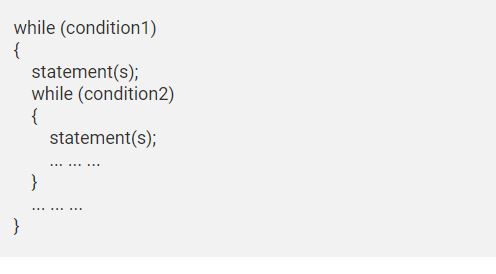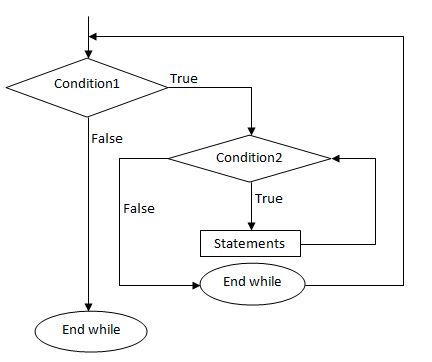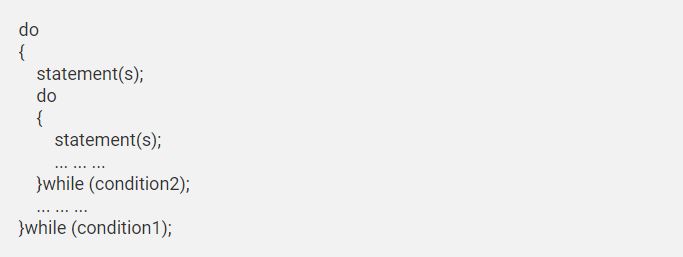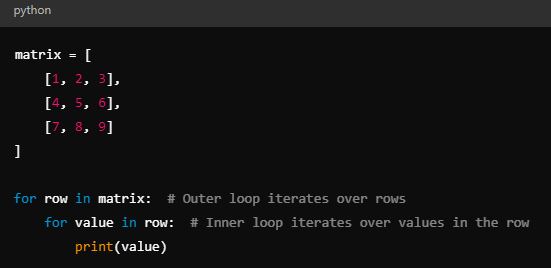What Is Nested Loop
A nested loop means a loop statement inside another loop statement. That is why nested loops are also called “loop inside loops“. We can define any number of loops inside another loop. A nested loop refers to placing one loop inside another, allowing for a more complex and comprehensive iteration over data sets or operations. This is particularly useful when dealing with multi-dimensional data structures, combinations, or scenarios where multiple layers of iteration are required. In a nested loop, each outer loop iteration triggers the execution of the entire inner loop.
A nested loop has one loop inside of another. These are typically used for working with two dimensions, such as printing stars in rows and columns, as shown below. When a loop is nested inside another loop, the inner loop runs many times inside the outer loop. In each iteration of the outer loop, the inner loop is restarted. The inner loop must finish all of its iterations before the outer loop can continue to its next iteration.
In programming, loops are fundamental structures used to automate repetitive tasks. A loop allows a set of instructions to be repeated either for a specific number of iterations or until a certain condition is met. However, some problems require iteration through multiple dimensions of data or involve more complex interactions between data sets. This is where nested loops come in handy.
For instance, imagine iterating over a two-dimensional array (like a matrix) or iterating through a set of combinations from two lists. These scenarios often require nested loops, which consist of one loop inside another. Nested loops are a powerful construct, but they come with challenges, such as increased complexity and potentially greater runtime.
In this article, we’ll break down what nested loops are, their use cases, benefits, and limitations, and dive deep into examples of how to use them in different programming languages. We’ll also cover some tips and best practices to help you write efficient code using nested loops.
Understanding of Loops
Before we dive into nested loops, it’s essential to have a good understanding of basic loops. There are several types of loops used in programming languages, each of which is suited to different types of repetitive tasks. Some common loop types are:
1 . Nested For Loop: A for loop inside another for loop is called a nested for loop. This loop is used when the number of iterations is known in advance.
Syntax of Nested For loop
Flowchart of Nested for loop

2. Nested While Loop: A while loop inside another while loop is called nested while loop. This loop runs as long as a specified condition remains true.
Syntax of Nested while loop

Flowchart of Nested while loop

3. Nested Do-While Loop: A do-while loop inside another do-while loop is called a nested do-while loop. Similar to a while loop, but it ensures that the code inside the loop is executed at least once, regardless of the condition.
Syntax of Nested do-while loop

Flowchart of Nested do-while loop

Nested Loops: A Deeper Look:
A nested loop occurs when a loop runs inside the body of another loop. The inner loop runs completely for each iteration of the outer loop. This creates a layered structure where the outer loop controls how many times the inner loop is executed. Here’s a basic example of a nested loop in Python:
Output:

Output:

Here’s how it works:
- The outer loop runs 3 times (for
ivalues of 0, 1, and 2). - The inner loop runs twice for each iteration of the outer loop (for
jvalues of 0 and 1).
Use Cases of Nested Loops
Nested loops have a wide variety of applications in real-world programming. Here are a few common use cases:
1. Iterating Over Multi-Dimensional Arrays
In many programming languages, arrays can have multiple dimensions (like 2D or 3D arrays). A 2D array can be visualized as a table, with rows and columns, and you may need to process every element in this structure. Nested loops allow you to access each element in such multi-dimensional arrays.
For example, in Python, a 2D array (list of lists) can be iterated over like this:

Output:

2. Generating Combinations of Two Sets:
Another common use of nested loops is generating combinations of items from two or more sets. Suppose you have two lists, one representing different types of beverages and the other representing different types of snacks. You can use nested loops to generate all possible combinations:
beverages = [“Coffee”, “Tea”, “Juice”]
snacks = [“Cookies”, “Chips”]
for a beverage in beverages: # Outer loop iterates over beverages
for a snack in snacks: # Inner loop iterates over snacks
print(f”{beverage} with {snack}”)
Output:
Coffee with Cookies
Coffee with Chips
Tea with Cookies
Tea with Chips
Juice with Cookies
Juice with Chips
3. Drawing Patterns
Nested loops are also commonly used in graphical programming and game development to draw complex patterns. For instance, you might want to print a pattern of stars or numbers using nested loops.
Example:

Output;

Here, the outer loop controls the number of rows, and the inner loop controls the number of stars in each row.
4. Searching in Matrices of Nested Loop
When working with 2D data structures like matrices, nested loops are often used to search for specific elements. For example, you might need to search for a number in a matrix.
The outer loop iterates over rows, while the inner loop checks each element within the current row.

Efficiency and Performance
While nested loops are a useful tool, they can significantly increase the computational complexity of a program. The runtime of nested loops is often O(n^2), where n is the number of iterations of the outer loop and the inner loop combined. This is acceptable for small data sets, but it can become problematic for larger sets of data, leading to slow execution times.
Time Complexity
When analyzing nested loops, it’s essential to understand their time complexity. Let’s break this down:
- If you have a single loop that iterates
ntimes, its time complexity is O(n). - If you nest another loop inside it that also iterates
ntimes, the time complexity becomes O(n) * O(n) = O(n^2).
Consider the following example:
for i in range(n): # Outer loop
for j in range(n): # Inner loop
print(i, j)
This has a time complexity of O(n^2) because for each iteration of the outer loop, the inner loop runs n times.
Space Complexity
Nested loops don’t necessarily increase space complexity unless you’re storing additional data in each iteration. However, be mindful of the memory requirements if you’re working with large data sets.
Nested Loops in Different Programming Languages
Nested loops can be used in almost all programming languages, though the syntax might differ slightly. Let’s look at examples in a few popular languages:
1. Python

2. JavaScript

3. Java:

4. C++:

Pitfalls of Nested Loops
Although nested loops are useful, they can also introduce potential pitfalls:
- Performance Issues: Nested loops can cause performance bottlenecks, especially if the number of iterations is large. This can lead to long execution times and poor performance in applications.
- Readability: Deeply nested loops can make code harder to read and maintain. If you find yourself with several levels of nesting, it might be time to rethink your approach or break your code into smaller, more manageable functions.
- Logical Errors: If not handled carefully, nested loops can introduce logical errors. For example, forgetting to reset the index of an inner loop can lead to incorrect results.
Best Practices for Using Nested Loops
To avoid some of the pitfalls associated with nested loops, consider the following best practices:
- Optimize When Possible: If you can achieve the same result without using nested loops, it’s often a good idea to avoid them. For example, consider using specialized algorithms or data structures that allow you to eliminate nested loops.
- Use Break Statements: If you’re searching for a value and can stop once you find it, use a
breakstatement to exit the loop early and improve performance.
for i in range(3):
for j in range(2):
if some_condition:
break # Exit the inner loop
For More rohaacademy. online


